Frigatebirds, members of the Fregatidae family, are remarkable seabirds renowned for their aerial prowess and distinctive appearance.
These sleek, black-plumaged birds are primarily found in tropical and subtropical regions worldwide, often inhabiting remote islands and coastal areas.
Characterized by their long, deeply forked tails, slender bodies, and huge wingspans, frigatebirds are built for efficient flight, capable of soaring effortlessly without landing.
One of their most notable features is the inflatable throat pouch of the male during the breeding season, which they use to attract mates through elaborate displays.
Despite their remarkable flying abilities, frigatebirds are relatively poor swimmers and rely on scavenging, piracy, and kleptoparasitism to obtain food, often harassing other seabirds to steal their catches.
These aerial marvels play a crucial role in marine ecosystems and continue to captivate bird enthusiasts and researchers’ fascination.
Physical Characteristics of Frigatebirds
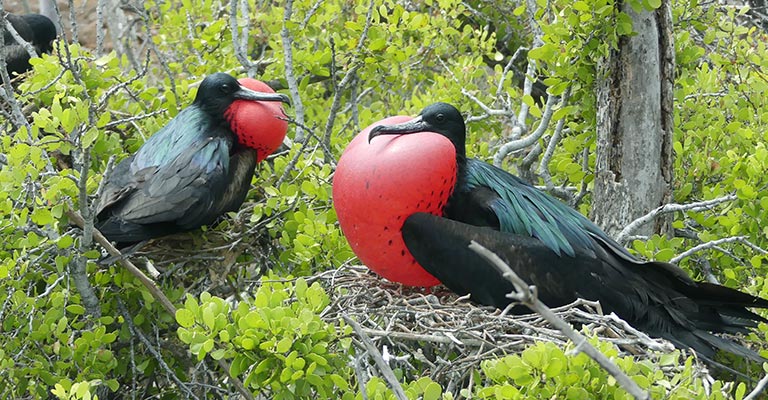
Identifying frigatebirds is fascinating, as these aerial masters possess several distinctive physical characteristics that set them apart from other seabirds.
Here are eight key points to aid in the identification of these remarkable birds:
Size and Shape
Frigatebirds are large seabirds with a distinctive silhouette characterized by long, pointed wings and deeply forked tails.
Their slender bodies have a wingspan ranging from 2 to 2.5 meters (6.5 to 8 feet), making them one of the largest seabirds in the world.
Coloration
Adult frigatebirds typically have black plumage overall, which appears glossy and iridescent in sunlight.
However, some species, such as the magnificent frigatebird, exhibit a slight greenish sheen on their feathers. Juvenile frigatebirds often have a brownish or mottled appearance, gradually acquiring the adult plumage as they mature.
Head and Neck
Frigatebirds have small, angular heads with sharply pointed bills. Their necks are long and slender, allowing for agile movement during flight.
Adult males of some species, notably the magnificent frigatebird, develop a distinctive red throat pouch during the breeding season, which they inflate to attract females.
Flight Pattern
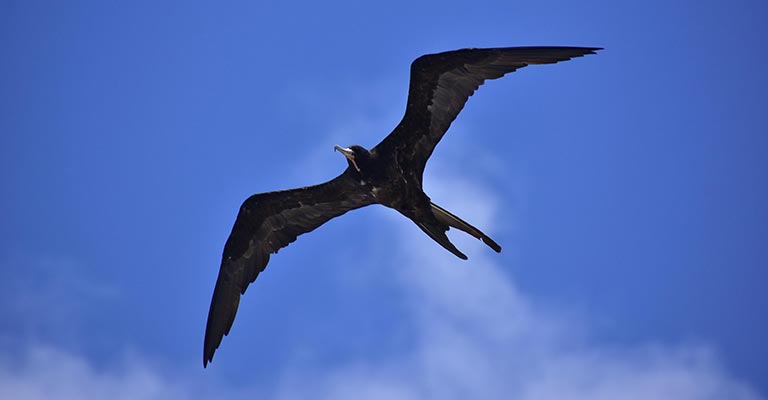
One of the most remarkable features of frigatebirds is their effortless and graceful flight.
They are adept at soaring for long periods without flapping their wings, using thermals and updrafts to stay aloft. Their flight pattern often involves soaring in circles high above the ocean, scanning for potential prey.
Tail
The deeply forked tail is a hallmark feature of frigatebirds. This unique tail shape aids in maneuverability and stability during flight, allowing them to navigate the air safely.
Legs and Feet
Frigatebirds have long, slender legs and webbed feet adapted for perching on branches or cliffs. However, they are relatively weak swimmers and rarely land on water except to bathe or drink.
Voice
While not particularly vocal, frigatebirds produce guttural and croaking sounds, especially during courtship displays or interactions at breeding colonies. These vocalizations can vary between species and individuals.
Behavior
Frigatebirds fly high above the ocean, scanning for opportunities to scavenge food from other seabirds or steal their catches.
They are highly skilled aerial predators, capable of precisely snatching flying fish or squid from the water’s surface.
Frigatebirds can be identified by their large size, distinctive silhouette, deeply forked tail, pointed bill, red throat pouch in males during the breeding season, graceful flight pattern, and unique vocalizations.
These physical characteristics and their remarkable aerial abilities make frigatebirds a captivating sight for birdwatchers and nature enthusiasts alike.
Taxonomy of Frigatebirds
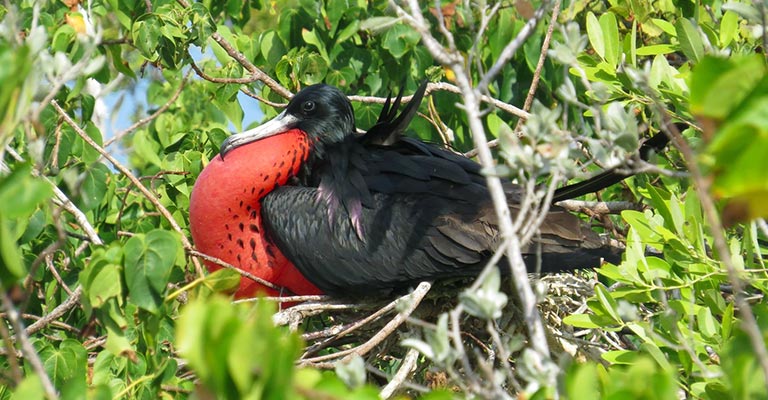
Here’s a table detailing the taxonomy of Frigatebirds:
| Taxonomic Level | Category |
| Domain | Eukaryota |
| Kingdom | Animalia |
| Phylum | Chordata |
| Class | Aves |
| Order | Suliformes |
| Family | Fregatidae |
| Genus | Fregata |
| Species | (various) |
The Great Frigatebird (Fregata minor), Magnificent Frigatebird (Fregata magnificens), and Lesser Frigatebird (Fregata ariel) are all members of the Fregatidae family, sharing many similarities in appearance and behavior.
Despite their shared characteristics, each species exhibits unique traits and distinctions.
Great Frigatebird (Fregata minor)
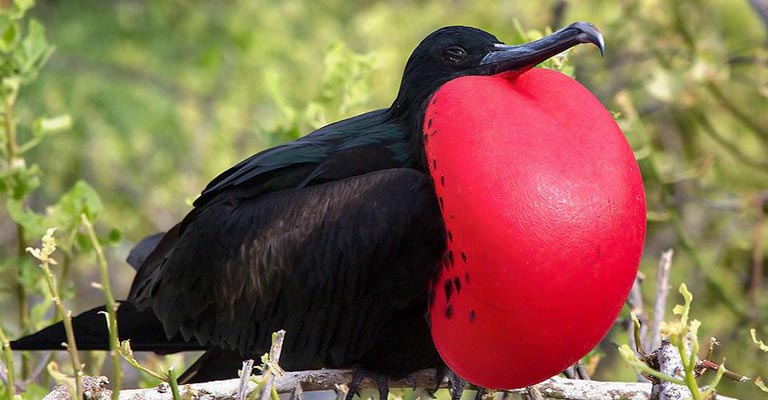
The Great Frigatebird is the largest species, with a wingspan reaching up to 2.3 meters (7.5 feet) and a body length of around 90 centimeters (35 inches).
It is primarily found in the Pacific and Indian Oceans, nesting on remote islands and atolls. Great Frigatebirds have black plumage with a greenish sheen, and adult males develop a bright red throat pouch during the breeding season.
They are skilled aerial predators, often seen soaring high above the ocean and using kleptoparasitic behavior to steal food from other seabirds.
Magnificent Frigatebird (Fregata magnificens)
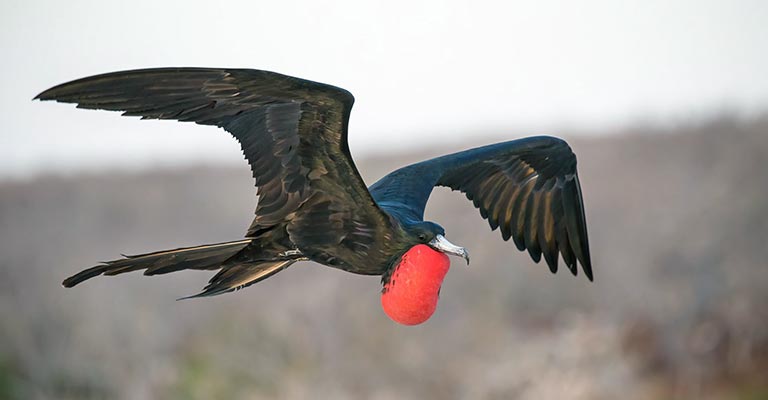
The Magnificent Frigatebird is renowned for its striking appearance, featuring a deeply forked tail, long wings, and glossy black plumage.
It is predominantly found in the tropical and subtropical regions of the Atlantic and Pacific Oceans, including the Caribbean and Gulf of Mexico.
Adult male Magnificent Frigatebirds develop a large, bright red throat pouch during the breeding season, which they inflate to attract females.
They are highly skilled aerial predators and often engage in elaborate courtship displays, including bill clattering and wing spreading.
Lesser Frigatebird (Fregata ariel)
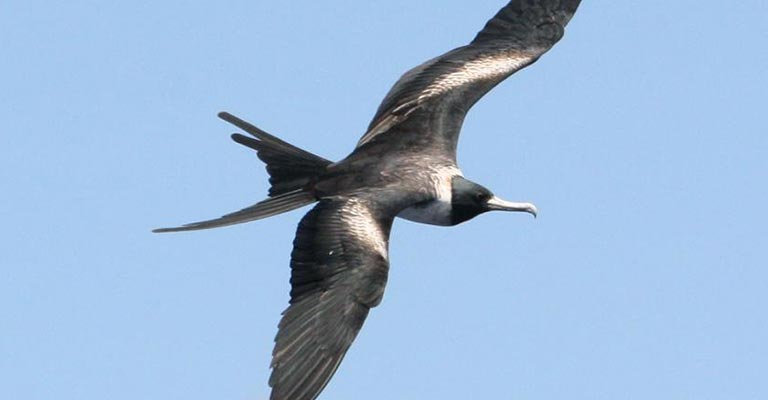
The Lesser Frigatebird is the smallest species, with a wingspan averaging around 1.8 meters (6 feet) and a more compact body than its larger relatives.
It is primarily found in the Indian and Pacific Oceans, often nesting on small, remote islands.
Lesser Frigatebirds have black plumage with a slight greenish sheen, and adult males develop a smaller, less conspicuous throat pouch during the breeding season.
They exhibit similar aerial hunting behavior to other frigatebirds, relying on kleptoparasitism and scavenging to obtain food.
Despite their differences in size and minor variations in appearance, all three species of frigatebirds share an everyday lifestyle characterized by their remarkable aerial abilities, kleptoparasitic behavior, and distinctive breeding displays.
They play vital roles in marine ecosystems and continue to captivate the imagination of bird enthusiasts worldwide.
Hunting Habit of Frigatebirds
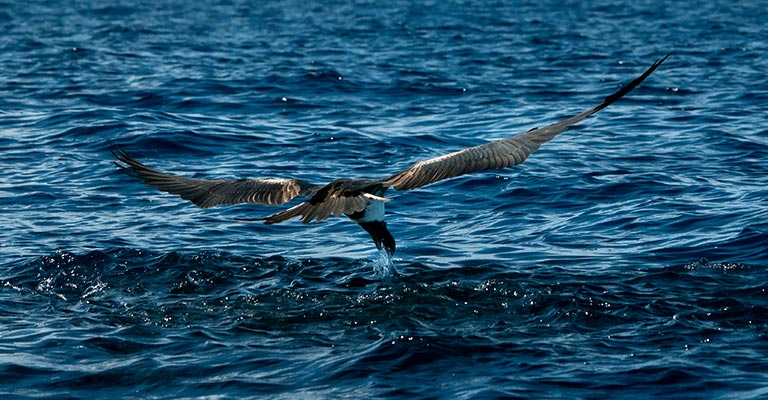
Frigatebirds are renowned for their unique hunting habits, primarily relying on kleptoparasitism and aerial piracy to obtain food.
Rather than diving or swimming for prey like many other seabirds, frigatebirds use their exceptional flying skills to harass and steal food from other birds in flight.
They often target smaller seabirds, such as boobies and terns, forcing them to regurgitate or drop their catches through intimidating aerial maneuvers.
Frigatebirds also scavenge for food by snatching flying fish or squid from the ocean’s surface. Their long wings and forked tails enable them to perform agile aerial maneuvers, allowing them to outmaneuver their prey.
This hunting strategy minimizes the energy expenditure required for foraging, making frigatebirds efficient predators of the open ocean.
Frigatebirds Life History
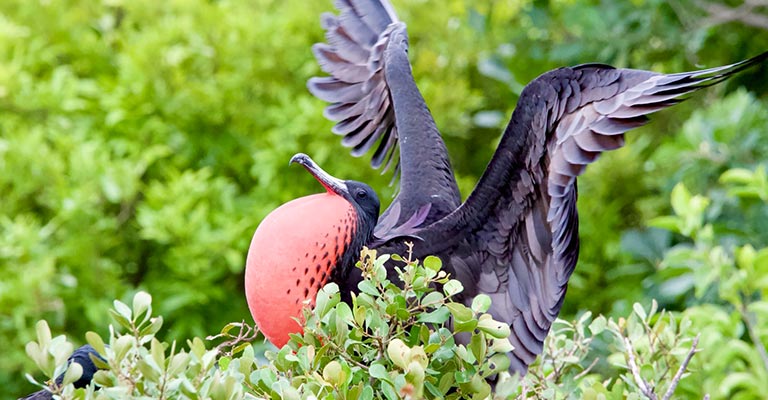
Frigatebirds, with their iconic silhouettes and remarkable aerial abilities, captivate the imagination of bird enthusiasts worldwide.
Their life history encompasses various aspects, from foraging habits to breeding behavior, highlighting their adaptation to a life spent predominantly in flight.
Food
Frigatebirds feed on fish, squid, and other marine organisms obtained through kleptoparasitism, harassing other seabirds to steal their catches.
They also scavenge by snatching prey from the ocean’s surface, utilizing their keen eyesight and agile flight to locate and capture food efficiently.
Habitat
Frigatebirds inhabit tropical and subtropical regions worldwide, favoring remote islands, coastal areas, and open ocean environments.
They often roost and nest in trees or cliffs, with nesting colonies on isolated islands far from mainland disturbances.
Range Map
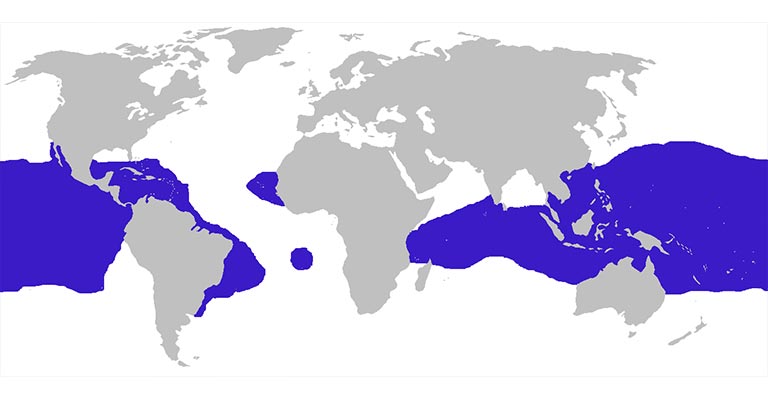
Frigatebirds are broadly distributed across the world’s oceans, with species such as the Magnificent Frigatebird found in the Caribbean, the Gulf of Mexico, and along Central and South American coasts.
The Great Frigatebird is prevalent in the Pacific and Indian Oceans, while the Lesser Frigatebird primarily inhabits the Indian and Pacific Oceans.
Breeding
Breeding among frigatebirds typically occurs in large colonies, with males displaying elaborate courtship behaviors to attract mates.
Nesting sites are often located in dense vegetation or on cliffs, where females lay a single egg. Both parents take turns incubating the egg and caring for the chick until it fledges.
Diseases and Treatment
Frigatebirds may be susceptible to diseases such as avian botulism or avian influenza, impacting their health and reproductive success.
Treatment for these diseases often involves supportive care, including hydration and nutrition, administered by wildlife rehabilitation experts.
Conservation
While frigatebirds are not currently considered globally threatened, they face various conservation challenges, including habitat loss, disturbance at nesting sites, and entanglement in marine debris.
Conservation efforts focus on protecting nesting colonies, mitigating human disturbances, and addressing threats such as overfishing and climate change to ensure the long-term survival of these majestic seabirds.
The life history of frigatebirds is a testament to their remarkable adaptation to a life spent navigating the vast expanse of the open ocean.
From their unique foraging habits to their role in marine ecosystems, frigatebirds continue to inspire awe and admiration among those who study and appreciate the wonders of the natural world.
Nesting Habit of Frigatebirds
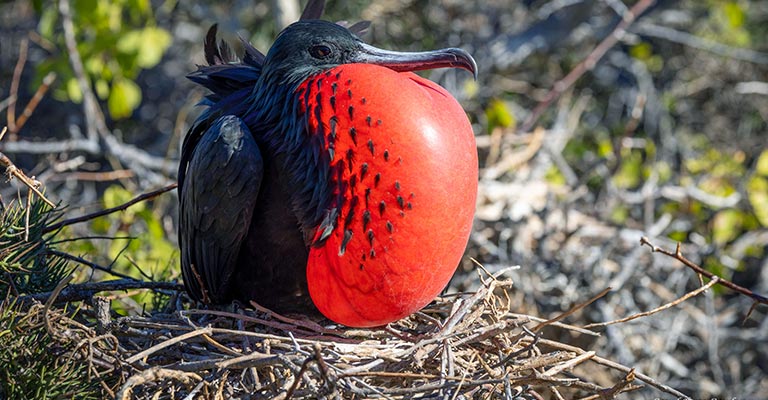
Frigatebirds typically nest in large colonies on remote islands or coastal cliffs, often surrounded by dense vegetation. Males establish territories and display elaborate courtship rituals to attract females.
Nesting pairs build rudimentary nests using sticks, twigs, and debris, usually placed high in trees or on rocky ledges, to minimize predation risks. Females lay a single egg, which both parents take turns incubating for around 40 to 45 days.
After hatching, the chick is cared for by both parents and remains in the nest for approximately two months until it fledges. Nesting colonies can be noisy and bustling with activity during the breeding season.
Below is a table detailing the nesting details of frigatebirds:
| Nesting Details | Frigatebirds |
| Clutch Size | Typically one egg |
| Number of Broods | Usually one per year |
| Egg Length | 6.5 – 7.5 |
| Egg Width | 4.2 – 4.8 |
| Incubation Period | Around 40-45 days |
| Nestling Period | Approximately 2 months |
| Egg Description | White with a calcareous shell, elongated shape |
10 Fun Facts About Frigatebirds
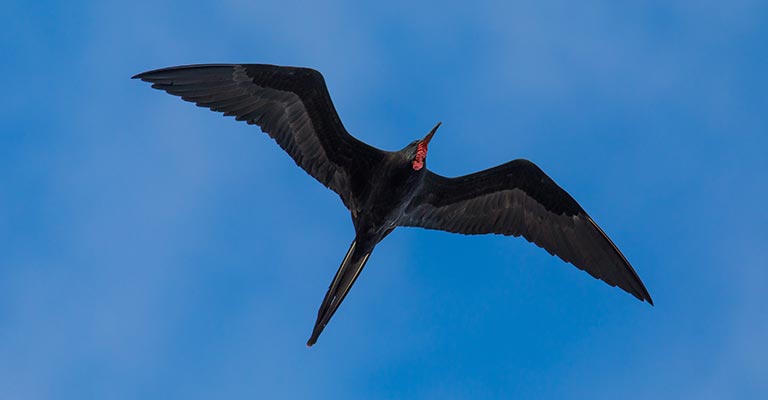
Frigatebirds, with their iconic silhouette and remarkable aerial prowess, are fascinating creatures that inhabit the world’s tropical and subtropical oceans. Here are 10 fun facts about these magnificent seabirds:
Master of the Skies
Frigatebirds are renowned for their exceptional flying abilities. With long, narrow wings and a deeply forked tail, they can soar for hours, utilizing thermals and updrafts to stay aloft.
Airborne Pirates
Frigatebirds are notorious for their kleptoparasitic behavior, often harassing other seabirds like boobies and terns to steal their catches. They use their agility and speed to snatch prey from their victims in mid-air.
Minimalist Nests
Unlike many other seabirds, frigatebirds build minimalistic nests consisting of a simple platform of twigs or branches. They often nest in colonies on remote islands, where suitable nesting sites are available.
Inflatable Pouches
During the breeding season, male frigatebirds develop a bright red throat pouch, which they inflate to attract females during courtship displays. The pouch size can reach impressive proportions, making it appear even more imposing.
Feather Maintenance
Frigatebirds have unique feather maintenance behaviors, including sunbathing and preening. Sunbathing helps them dry their feathers and regulate their body temperature, while preening removes dirt and parasites.
Long-distance Travelers
Frigatebirds are highly migratory birds, undertaking long-distance journeys across the oceans in search of food and suitable nesting sites. Some individuals have been known to travel thousands of kilometers during migration.
Limited Swimming Abilities
Despite spending much of their lives over the ocean, frigatebirds are relatively poor swimmers. Their long wings and light bodies make it difficult for them to maneuver in the water, so they rarely land on the sea except to bathe or drink.
Delayed Sexual Maturity
Frigatebirds have a relatively long lifespan and reach sexual maturity at around seven years of age. Once they start breeding, they may continue to do so for several decades, contributing to the stability of their populations.
Vocal Communicators
While not particularly vocal compared to other seabirds, frigatebirds produce various sounds, including guttural calls and bill clattering, especially during courtship displays or interactions at nesting colonies.
Conservation Concerns
Despite their adaptability and widespread distribution, frigatebirds face various conservation challenges, including habitat loss, disturbance at nesting sites, and entanglement in marine debris.
Conservation efforts are crucial to ensuring the long-term survival of these majestic seabirds.
Frigatebirds are fascinating creatures with unique traits and behaviors that intrigue researchers and bird enthusiasts alike.
Wrapping Up
Frigatebirds stand out as remarkable creatures of the open ocean, captivating us with their aerial prowess, distinctive appearance, and fascinating behaviors.
From their effortless soaring to their ingenious kleptoparasitic hunting tactics, these seabirds exemplify adaptability and resilience in their marine habitats.
However, as they navigate the challenges of a changing environment and human impacts, it’s imperative to prioritize conservation efforts to safeguard their populations.
By preserving their nesting sites, mitigating disturbances, and addressing threats such as habitat loss and pollution, we can ensure that frigatebirds continue to grace our skies and inspire awe for generations to come, reminding us of the beauty and importance of our marine ecosystems.